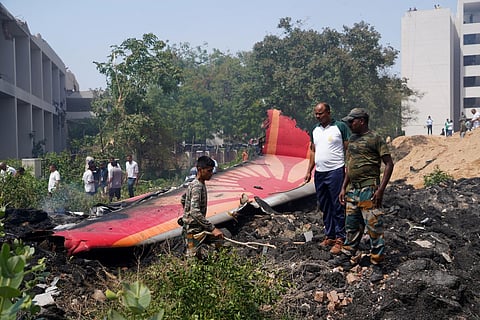Bomb threat, technical issues, no aircraft — Air India's woes don't seem to end
Flight delays, snags, cancellations raise questions as Air India battles deeper challenges

Dubai: In the weeks following the tragic crash of Air India Flight 171 in Ahmedabad, which claimed the lives of 241 people, India's national carrier has seen a noticeable uptick in technical issues, emergency landings, and flight cancellations — sparking concern among travellers and aviation observers.
On Sunday, Air India Express flight IX110 from Hyderabad to Phuket turned back after just 16 minutes in the air due to a similar technical issue. While passengers and crew landed safely, the incident was among several return-to-origin cases logged by the airline this past month alone and it adds to a growing list of recent operational disruptions.
Disruptions not limited to technical faults
These aren’t isolated cases. Since mid-June, Air India and its low-cost subsidiary Air India Express have faced a string of challenges:
Flight AI315 — a Boeing 787 Dreamliner operating between Hong Kong and Delhi — was forced to return mid-air after the crew detected a technical fault.
Flight AI143 from Delhi to Paris was cancelled due to a technical issue during pre-flight checks. The return flight from Paris also had to be called off due to night-time operation restrictions.
A flight from Ahmedabad to London Gatwick was cancelled, not due to mechanical faults, but aircraft unavailability caused by post-crash checks.
Dubai–Jaipur Air India Express flight reported being kept onboard for five hours without air conditioning or food, following a technical snag.
Air India flight from Phuket to Delhi, airborne a day after the crash, requested an emergency landing after a bomb threat, later found to be a hoax.
In Kolkata, a San Francisco–Mumbai flight was stopped mid-route due to an engine issue found during a routine check at its scheduled stop.
Air India Express flight IX-2564 from Delhi to Srinagar via Jammu returned to the capital on Monday due to a technical issue. It was scheduled to land in Jammu but circled airport before pilot opted to return to Delhi.
Air India Express cancelled two UAE-bound flights from Thiruvananthapuram on Sunday due to operational reasons — IX 539 to Dubai and IX 537 to Abu Dhabi.
Bloomberg reported that over 80 Air India flights were cancelled in the week following the crash, including both technical and non-technical disruptions. Passengers have also raised concerns over faulty in-flight systems and limited communication — contributing to a broader sense of unease.
Challenging journey since the Tata takeover
Since the Tata Group’s acquisition of the formerly state-owned airline in early 2022, Air India has been working to reverse years of decline. The plan was ambitious: merge four airline brands (Air India, Vistara, Air India Express, and AirAsia India), overhaul aging aircraft, and modernise operations.
But the crash has forced a reset. Post-crash safety checks and enhanced maintenance protocols have reduced aircraft availability, impacting long-haul and international schedules. Air India has already announced a 15% cut in long-haul services to stabilise operations.
Even before the crash, the airline was facing turbulence — frequent delays, aging aircraft, and a brand struggling to match rising customer expectations in a competitive global aviation landscape.
Regulatory spotlight and pressure to reform
India’s Directorate General of Civil Aviation (DGCA) has since ordered enhanced surveillance of Air India’s Boeing 787 fleet, raising questions on whether oversight was adequate before the incident.
Aviation experts argue that the issues run deeper than any one airline. “It’s the entire ecosystem — maintenance, staffing, training, air traffic infrastructure — that must keep pace,” says Kapil Kaul, CEO of aviation consultancy CAPA India.
India is one of the world’s fastest-growing aviation markets, with over 800 planes and 242 million passengers annually — a number expected to double in five years. But with such growth, the margin for error narrows. Analysts now call for structural reforms in regulation, fleet management, and route planning.
What lies ahead
For now, Air India is caught between transformation and turbulence. The Tata Group has weathered difficult turnarounds before — such as Jaguar Land Rover — and may yet steer the airline through.
But to regain trust, especially after a fatal crash, transparency, steady operations, and clear communication will be key. With every cancellation, every turned-around flight, the spotlight will only grow brighter.
Sign up for the Daily Briefing
Get the latest news and updates straight to your inbox




